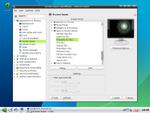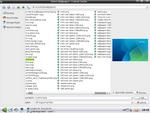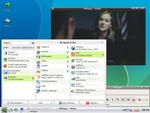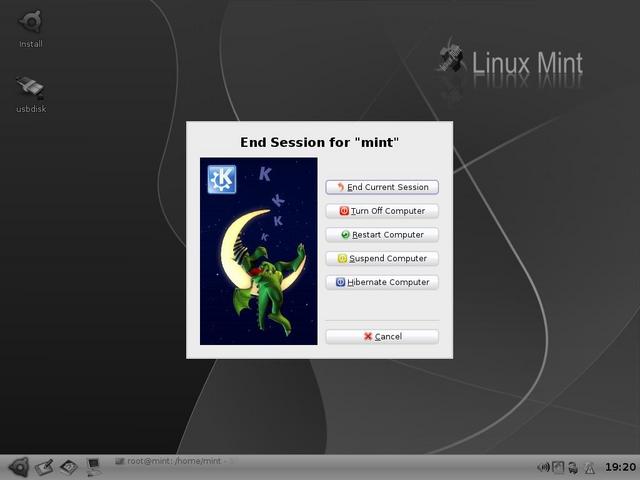Linux Minty Fresh



 Linux Mint is the prettiest incarnation of the Ubuntu family, yet it doesn't seems to get the same attention as its *buntu parents. I've been wanting to be able to use Mint since my first little test run of a beta of 2.2, but at that time wireless support shattered those plans. So, when 2.2 was released in a KDE flavor, I just had to test it again.
Linux Mint is the prettiest incarnation of the Ubuntu family, yet it doesn't seems to get the same attention as its *buntu parents. I've been wanting to be able to use Mint since my first little test run of a beta of 2.2, but at that time wireless support shattered those plans. So, when 2.2 was released in a KDE flavor, I just had to test it again.
I tested an earlier 2.2 about the same time eco2geek, a tuxmachines regular and contributor best known for his Knoppix on USB howto, posted his review of the beta. At that time I was a bit impressed with some elements of Mint, but the lack of wireless support was a show stopper for me.
The version I downloaded was over 800mb, but there is a smaller version that will still fit on a regular 700mb cdrom. The boot screen is attractive light text on dark background featuring the Linux Mint logo. One can choose from Start Linux Mint, starting in safe graphics mode, or booting from the first hard disk. If you depress F6, you can add any boot options needed. The silent boot splash again is dark with Bianca displayed in cursive text with another variation on the Linux Mint logo and a green busy bar. One is bothered with a login and is taken directly to the desktop through a nice full screen kde start splash that matches the default background.
The desktop is attractive and uncluttered having only one icon on the desktop and only a few quick launchers and applets in the system tray. It is distinguishably KDE and features a Linux Mint icon for the start menu button. The default wallpaper is an abstract in cool colors of light blue and green with intersecting uneven sections making up differing hues. It has a calm and refreshing feel to it. In the /usr/share/wallpaper directory one can find many wallpapers from which to choose. I liked the default, but found one I liked even better. It's a darker abstract with more wavy dividers. But it was hard choosing, as there as several really nice ones. It's getting harder and harder for developers to include a selection of backgrounds as space becomes more and more cramped. Likewise, many times a developer may have to sacrifice some screensavers. Not so with Mint, as it is delivered with the full array of screensavers. Even using the default graphics setup the gl screensavers work really well.
The window decoration and style and very nice looking as well. The windec is Crystal and is presented in a neutral dark and lighter gray colors. The window buttons change color when hovered. The Domino style has a nice 3D-like appearance and comes with rounded corners on the buttons, tabs, drop down menus, and scroll bar. It is delivered in lovely snowy colors. The progress bar is an animated candy cane of white and gray. The fonts do appear nicer in person that portrayed in the screenshots.
The menu is user-friendly and easy to navigate. It's a 3-paned extended menu that makes it easy to see where you're going and from where you've come. The only movement is when one uses the scrollbar to move the list in the last pane. It contains a search function as well as remembering your favorites and history. In the upper right hand corner is a docking arrow. This action actually separates the menu and makes it behave like an individual windowed app.
Overall one gets a real nicely polished feel from using the desktop.



I tested this release on my HP notebook. The system booted in average time and detected most hardware present. By default, I was given a 1074x768 desktop, which surprisingly didn't looked distorted. In prior testing I had no trouble adjusting this to my desired 1280x800. Sound and touchpad worked at boot. Removeable media such as USB keys are auto-detected upon insertion. Power management seemed limited to battery monitoring as cpufreq didn't appear to be included (or enabled by default). Suspend options weren't tested in the livecd mode. My wired ethernet chip was detected and the dethforce module was loaded.
My wireless was correctly detected, but the Linux supplied bcm43xx doesn't work for me. I rmmod that module and his buddies then used ndiswrapper to install the windows driver. However, in attempts to load the ndiswrapper modules resulted in nondescript errors. Thus no device was made. My wireless network was unusable yet again as found in early beta testing. Perhaps Mint's version of ndiswrapper needs updating. For those whose chips may be supported, there are several graphically wifi kapps available.
The list of applications includes not only the sum of KDE apps, but some others as well. Instead of OpenOffice.org we have Koffice, a viable replacement for the average home user. Mint includes Dolphin, Krusader, as well as Konqueror for graphical file management. There are smaller text editors, package management tools, and search facilities. It comes with Guarddog to help one construct a firewall. There's The Gimp, Inkscape, Hugin, digiKam and Krita for image and photo viewing and manupulation. Gwenview is the default image viewer that open when an image file is clicked. There's a wide variety of internet and communication tools for connecting, downloading, chatting, and surfing. Firefox is included and at version 2.0.0.3. k9copy and K3b are included for cd and dvd creation. Kaffine and Mplayer are present for video enjoyment. KsCD and Amarok are there for music. Under the hood we find a 2.6.17 kernel, X 7.1.1, and gcc 4.1.2.
I had no problems with any of the applications in my brief testing. Mplayer had no trouble with my video files on hand no matter the format. Without internet, I was able to test browser plugins or Adept.



Without wireless support I wasn't really interested in a harddrive install for myself, but I thought I'd test it for the review. Whereas it's a nice graphical user-friendly and logically planned installer, it wasn't able to complete the install here. Things went fine until the partition setup when I received a "Critical error during ped_disk_duplicate!" My disk was originally partitioned by openSUSE and I haven't had any trouble with installing other distros.
My conclusion of Linux Mint is that I find it a very nice looking distribution with a well rounded selection of applications. I liked the menu structure very much. But I find it still needs a bit more refinement in the area of some hardware aspects. Even if wireless support wasn't a showstopper for me, not being able to install definitely was. I have no idea how much of these problems are inherited from its parents as I've not tested any of the *buntu in a while other than Linux Mint. I personally like the inclusion of the extra codecs and plugins that make a modern distro enjoyable, so I will be keeping an eye on this project. I understand it has plenty of satisfied users. You might be able to become one of them.
Linux Mint Homepage.
Mint @ Distrowatch.
More Screenshots.

-

- Login or register to post comments
 Printer-friendly version
Printer-friendly version- 91452 reads
 PDF version
PDF version
More in Tux Machines
- Highlights
- Front Page
- Latest Headlines
- Archive
- Recent comments
- All-Time Popular Stories
- Hot Topics
- New Members
today's howtos
| Red Hat Hires a Blind Software Engineer to Improve Accessibility on Linux Desktop
Accessibility on a Linux desktop is not one of the strongest points to highlight. However, GNOME, one of the best desktop environments, has managed to do better comparatively (I think).
In a blog post by Christian Fredrik Schaller (Director for Desktop/Graphics, Red Hat), he mentions that they are making serious efforts to improve accessibility.
Starting with Red Hat hiring Lukas Tyrychtr, who is a blind software engineer to lead the effort in improving Red Hat Enterprise Linux, and Fedora Workstation in terms of accessibility.
|
Today in Techrights
| Android Leftovers |









.svg_.png)
 Content (where original) is available under CC-BY-SA, copyrighted by original author/s.
Content (where original) is available under CC-BY-SA, copyrighted by original author/s.

Improvement has a cost?
Interesting observations. It is hard to imagine why some thing would be affected negatively by the inclusion of more packages. If anything, it justifies relying on the 'mainline' distros and building on from there.
re: Improvement has a cost?
I couldn't get my wireless to work in the last ubuntu tested either. It's probably inherited.
The OEMs are truly needed
The OEMs are truly needed here. Dell has promised it would contribute GPLed drivers to usher its arrival into the Linux laptops market. I am still waiting to see H-P's decision. Bernard Golden seems to suggest that they still evluate their Linux options 'in house'.
Laptops that were asembled to work 'hand in glove' with Windows make judgment difficult (the desktop readiness meme). Bear in mind that some Toshiba units simply cannot be upgraded from XP to Vista either, based on Microsoft's own KB (!!).
wireless driver
ndiswrapper driver with Linux Mint 2.2 works fine. I had the same problem with it not working until I blacklisted the bcm43xx driver. It must have been interfering with ndiswrapper. Try blacklisting the bcm43xx driver.
re: wireless driver
not the same effect as rmmod'in it? usually that's all that's needed. I usually blacklist modules so wireless will work upon reboot without fiddling with it, but I can't get Linux Mint installed anyway.
wireless driver
No. For some reason when I rmmod'd the bcm43xx after booting to the desktop, ndiswrapper didn't work. But when i blacklisted the driver and rebooted ndis worked.
re: wireless driver
Well, that's good to know. Don't help much with the livecd tho.
Thanks.
re: wireless driver
Happy to say that Mint's ndiswrapper did work for me on my Compaq Presario V2000, from the live CD, without having to blacklist the bcm43xx driver.
It uses "bcmwl5a.inf" and "bcmwl5a.sys" as its Windows drivers, but I downloaded them from the links on the ndiswrapper wiki (and transferred them over on a USB key) because for some odd reason the ones from the Windows partition didn't work. So there's an option for you.
The real "issue" with this laptop is that it's got an ATI Radeon Xpress 200M graphics chipset, which will only run compiz/beryl using XGL. That's the main reason I'm using openSUSE on it instead of a Debian-based distro. Wonder how well Ubuntu does with XGL.